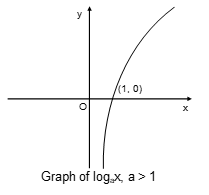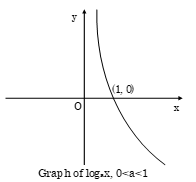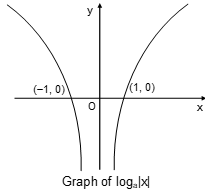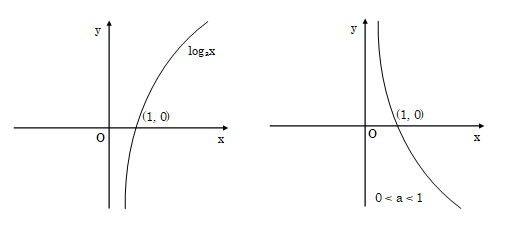If a > 0 and a ≠ 1, then logarithm of a positive number m is defined as the index x of that power of 'a' which equals m i.e. logam = x iff ax = m
alogam = m ......(1)
The function defined by f(x) = logax, a > 0, a ≠ 1 is called logarithmic function. Its domain is (0, ∞) and range is ℝ.
When base is 'e' then the logarithmic function is called natural logarithmic function and when base is 10, then it is called common logarithmic function.
Graph of logarithmic functions

y = logax, a > 1
(i) When 0 < x < 1:
x = ay.
That is, we have to choose those values of y for which 0 < ay < 1.
Since a > 1, y ≤ 0 ⟹ y ∈ (-∞, 0).
(ii) When x = 1:
x = ay.
We have to choose that value of y for which x becomes 1 ⟹ y = 0.
(iii) When x > 1:
x = ay.
We have to choose those values of y for which x > 1.
Since a > 1, 0 < y < ∞.

y = logax, 0 < a < 1
(iv) When 0 < x < 1:
we have to choose those values of y for which 0 < ay < 1.
Since 0 < a < 1, y > 0.
(v) When x > 1:
we have to choose those values of y for which ay > 1.
Since a < 1, y < 0.
Graph of loga|x|:
loga|x| is an even function. Hence its graph will be symmetrical about the y-axis.

Graph of loga|x|
Properties of Logarithmic Functions
(i) logax1 + logax2 + .... + logaxn = loga(x1x2 ....xn).
(ii) logax1 - logax2 = loga(x1/x2).
(iii) logamx = (1/m)logax.
(iv) logaxn = (n/m)logax.
Changing the Base
logba = logca / logcb
In general:
logba = logca × logdc × loged × ... × logbk
Also logca = (logba)/(logbc)
logaa = (logba)/(logba) = 1
and logba = 1/(logab)
Remark: Any real number n > 0 can be written as n = alogan.
Inequalities in logarithm
Let logap > logaq.
Let us assume that x = logap ⟹ p = ax
and y = logaq ⟹ q = ay.
Let x > y.
If a > 1
then ax > ay ⟹ p > q.
If 0 < a < 1,
ax < ay ⟹ p < q.
Key Points for Inequalities
- If a > 1, p > 1, then logap > 0.
- If 0 < a < 1, p > 1 ⟹ logap < 0.
- If a > 1, 0 < p < 1 ⟹ logap < 0.
- If p > a > 1 ⟹ logap > 1.
- If a > p > 1 ⟹ 0 < logap < 1.
- If 0 < a < p < 1 ⟹ 0 < logap < 1.
- If 0 < p < a < 1 ⟹ logap > 1.
Illustration 1: The value of (0.16)log2.5(1/3) + (1/3)-∞ is equal to
(A) 4
(B) 5
(C) 6
(D) 7
Solution (A):
Let A = (0.16)log2.5(1/3) + (1/3)-∞ = (0.4)2log2.5(1/2)
= (2/5)log2.5(1/2) = (2/5)log5/2(1/2)
= (2/5)log5/2(1/2) = (5/2)log5/24 = 4.
Illustration 2: If ln2. logb625 = log1016. ln10, then the value of b is
(A) 4
(B) 5
(C) 6
(D) 7
Solution (B):
We have ln2. logb54 = log1024. ln10
⟹ 4 ln2. logb5 = 4log102. ln10
⟹ ln2. logb5 = (ln2/ln10). ln10
⟹ logb5 = 1 ⟹ b = 5.
Exercise 1
Ques. If logax, logbx, logcx are in A.P. where x ≠ 1, then
(A) a² = (bc)logba
(B) c² = (ac)logab
(C) b² = (ac)logcb
(D) none of these
Ques. If n is a natural number such that n = p₁a₁ · p₂a₂ · p₃a₃ ......pkak where p₁, p₂, p₃, …., pk are distinct prime numbers, then
(A) log n > k log 2
(B) log n < k log 2
(C) k log n > log 2
(D) k log n < log 2
Ques. The value of x satisfying |x-1|log₃x²-2log₃9 = (x-1)⁷ is/are
(A) 27
(B) 4
(C) 2, 81
(D) none of these
Ques. xlog y - log z · ylog z - log x · zlog x - log y is equal to
(A) log x
(B) log y
(C) 0
(D) 1
Ques. If log₃ 2, log₃ (2x – 5), log₃ (2x – 7/2) are in A.P., then x is equal to
(A) 3
(B) 4
(C) 5
(D) 6
Answer to Exercises
(i) B
(ii) A
(iii) C
(iv) D
(v) A
Formulae
- alogam = m
- When base is e, then logarithmic function is called natural logarithmic function and when base is 10, then it is called common logarithmic function.
- logaxn = (n/m)logax
- logca = (logba)/(logbc)
- logap > logaq
- p > q if a > 1
- p < q if 0 < a < 1
- Graph of logax shows different behaviors for a > 1 and 0 < a < 1

Solved Examples
Problem 1: If log₄5 = a and log₅6 = b, then log₃2 is equal to
(A) 1/(2a+1)
(B) 1/(2b+1)
(C) 2ab + 1
(D) 1/(2ab+1)
Solution (D): 4ᵃ = 5; 5ᵇ = 6 ⟹ (4ᵃ)ᵇ = 6; ⟹ 2²ᵃᵇ = 2¹·3; 2²ᵃᵇ⁻¹ = 3
(2ab - 1) log₂2 = log₂3 ⟹ log₃2 = 1/(2ab+1).
Problem 2: The value of log₃4 log₄5 log₅6 log₆7 log₇8 log₈9 is
(A) 1
(B) 2
(C) 3
(D) 4
Solution (B): log₃4 log₄5 = log₃5; log₅6 log₆7 = log₅7; log₇8 log₈9 = log₇9
⟹ given expression = log₃5 log₅7 log₇9 = log₃9 = 2.
Problem 3: If a = log₂₄12, b = log₃₆24 and c = log₄₈36, then 1 + abc is equal to
(A) 2ab
(B) 2ac
(C) 2bc
(D) 0
Solution (C): 1 + abc = 1 + log₂₄12 log₃₆24 log₄₈36 = 1 + log₄₈12
= log₄₈48 + log₄₈12 = log₄₈(48 × 12) = log₄₈(24)² = 2log₄₈24 = 2log₄₈36 log₃₆24 = 2bc.
Problem 4: If log x : log y : log z = (y - z) : (z - x) : (x - y), then
(A) xᵗ·yᶻ·zˣ = 1
(B) xˣ yʸ zᶻ = 1
(C) xˣ⁺ʸ yʸ⁺ᶻ zᶻ⁺ˣ = 1
(D) none of these
Solution (B): (log x)/(y-z) = (log y)/(z-x) = (log z)/(x-y) = k
⟹ x log x + y log y + z log z = k[x(y-z) + y(z-x) + z(x-y)] = 0
⟹ log xˣ + log yʸ + log zᶻ = 0 ⟹ xˣ · yʸ · zᶻ = 1.
Problem 5: xlogxy + logyz is equal to
(A) x
(B) y
(C) z
(D) none of these
Solution (C): Given expression = xlogxz = z.
Problem 6: The sum of the series 1/loga2 + 1/loga4 + 1/loga8 + ..... upto n terms is
(A) n(n+1)/(2 loga2)
(B) n/(2 loga2)
(C) (n+1)/(2 loga2)
(D) n(n+1)(2n+1)/(6 loga2)
Solution (A): The given expression can be written as loga2 + loga4 + loga8 + .... upto n terms = loga2 + 2 loga2 + 3 loga2 + .... n loga2 = loga2 [1+ 2 + ... n] = (n(n+1))/(2) loga2.
Problem 7: The value of 'b' satisfying log√b b = 3⅓ is
(A) 30
(B) 31
(C) 32
(D) 33
Solution (C): We have log√b b = 3⅓ ⟹ logb^(1/2) b = 10/3
⟹ (2/3) logb b = 10/3 ⟹ log₂b = 5
⟹ b = 2⁵.
Problem 8: The value of x, satisfying loga(1 + logb{1 + logc(1 + logpx)}) = 0, is
(A) 4
(B) 3
(C) 2
(D) 1
Solution (D): The given equation yields 1 + logb{1 + logc(1 + logpx)} = 1
⟹ logb{1 + logc(1 + logpx)} = 0
⟹ 1 + logc(1 + logpx) = 1
⟹ logc(1 + logpx) = 0
⟹ 1 + logpx = 1
⟹ logpx = 0
⟹ x = 1.
Problem 9: For 0 < x < 1, the value of log(1 + x) + log(1 + x²) + .... to ∞ is
(A) log(1 - x)
(B) -log(1 - x)
(C) log x
(D) -log x
Solution (B): The given expression = log [(1 + x) (1 + x²) ..... to ∞ ]
= log[ 1+ x + x² + x³ + .... to ∞ ]
= log(1/(1-x))
= -log(1 - x).
Problem 10: The value of x satisfying 184x-3 = (54√2)3x-4 is
(A) 2
(B) 6
(C) 3
(D) 4
Solution (B): Here 184x-3 = (54√2)3x-4.
Taking log on both sides, we get
(4x - 3) log18 = (3x - 4) log(54√2)/2
⟹ (4x - 3) log18 = (3x - 4) log(18)^(3/2)
⟹ (4x - 3) = (3x - 4). 3/2
⟹ x = 6.